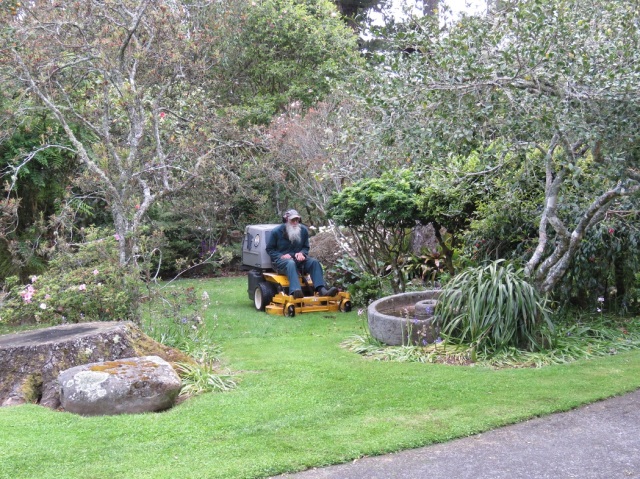
Despite my intentions, life has got in the way and I have not been out and about visiting gardens and artist’s studios open on various trails this week in Taranaki as much as I thought I would. But I did get to three gardens on Thursday, which is about my limit for a day.

First up was Three Elms, in New Plymouth which exceeded my expectations. The owners, Shane and Lisa McNab, have always credited us with inspiring them to garden – albeit several decades ago – and they tell me they made their first plant purchase from us. It was a pot of rhodohypoxis. They have clearly learned a huge amount in the time since.

Three Elms is a town garden on a section that is not large but started out as a steep challenge. It is a due to their hard work and thoughtfulness that the gradient is no longer a problem. They have created small terraces with fairly easy transitions between them, belying the original slope and making moving around the area straightforward. Talk to Shane, if you visit, about the lengths he had to go to installing the large boulders and rocks that are used extensively. They are a feat of determination and physical effort.

The hard landscaping provides the framework but it is the plantings that star. As they should, in my opinion. Pretty much every square metre has been carefully thought about and tended with skill and care over many years and it shows in the plant selections, the health of the plants and the harmonious combinations. There are a lot of bromeliads but it is not only bromeliads, by any manner of means.

Gardens are only work if you don’t enjoy what you are doing. Three Elms has had a lot of time, thought, skill and – yes – love given to it over many years and it shows. If you are out and about garden visiting locally this weekend, go and see it.

Hurworth Country Garden also delighted me. I had been to an event there late last year but events distract from looking at a garden and I wanted to have a better look. I was about a third of the way around it when I found myself thinking, “This is a really graceful garden” and that is not a descriptor that I have ever used about a garden before.

It is pretty large for a retirement garden situated just beyond the city limits and immaculately presented, but that high level of maintenance doesn’t interfere with the feeling of relaxed charm and space – and indeed, grace. Again, it reflects the skill, experience and thought of its owners, Jan and Graeme Worthington. I do like a thoughtful garden.


Jan’s use of colour is subtle but not monochromatic. When I commented on this, she put it down to her experience in quilt making. I haven’t seen her quilts but I imagine they are as immaculate and harmonious as her garden.

They also have one of the loveliest garden rooms I have seen and I do like a good garden room. I didn’t even think to ask how and when they use it when the garden is not open to the public; it is perhaps a little too far from the house to use for summer meals and entertaining but it is the sort of room I could visualise sitting in myself, just to enjoy the ambience and views. Hurworth is a garden with a particularly lovely ambience.

The third garden I went to was Kowhai Garden which has a remarkable collection of rhododendrons – over 900, I believe. It is not just rhododendrons but they are the stars at this time of the year. I entertained myself identifying those I knew, dredging my memory banks from the days when we had a nursery that specialised in the genus. Again, it is an example of how people cope with gardens that include a very steep slope, as much of this large garden has. What stood out for me were the rhododendrons that are thriving in a low maintenance environment – not only flowering well but also keeping good foliage and good plant form. Some are performing much better than others.


Near the house is an outstanding plant of ‘Lemon Lodge’ – simply the best specimen I have ever seen.

Also looking lovely were plants of R.nuttallii x lindley hybrids – these ones are ‘Floral Fete’, the owner, Neil Tapsell told me. There used to be a number of named forms of this cross around including the likes of ‘Mi Amor’, ‘Stead’s Best’ and ‘White Waves’. I am not sure how many are still available commercially but it remains a beautiful hybrid and ‘Floral Fete’ is as good as any of the forms I have seen and arguably better than ‘Mi Amor’.
Here endeth my summary of Thursday’s garden visits. I am hoping to get to see another couple over the weekend but the arrival today of our most beautiful Jury hybrid, our little baby granddaughter accompanied by her mama, may yet derail my plans.















































